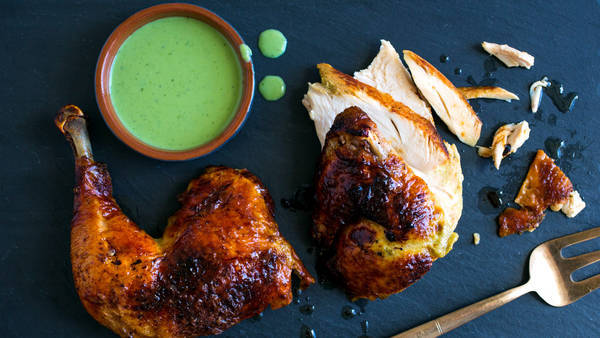Thomas Keller Ad Hoc Fried Chicken Recipe
Joyce Park stashed this in Food
Stashed in: Good Eats!, Meat!, Yum, Things that should get eaten
The one time I had this dish, I don't recall it having a lemon flavor.
So lemon brining does not make the fried chicken taste lemony.
I think this recipe was written to fit the house style at the magazine, not necessarily to strictly reflect how the chicken is best cooked. I have some suggestions:
* Frying chicken is basically a technical activity. As every geek knows, every technical activity starts with HARDWARE. Go out and buy a spatter screen, one of those large shakers that pizza parlors use to serve oregano, a candy thermometer AND an instant-read meat thermometer (or a digital probe thermometer that goes up to at least 400 degrees), and one wire cooling rack for each chicken you plan to fry at a time. You should already have a very large pot or pan, and one baking sheet per chicken. If you try to make chicken without all of these items, you are doomed to failure.
* This is an alternate version of the same recipe:
http://www.epicurious.com/recipes/member/views/THOMAS-KELLERS-BUTTERMILK-FRIED-CHICKEN-50000340
I'm not 100% in favor of this one either, but it's interestingly different in spots.
* In the restaurant, I'm pretty sure the chicken is cut into TEN pieces. They fry and serve the wings, and cut each breast in half.
* I've never particularly understood recipes that call for things to be brined or marinated overnight. Who wants to get up in the morning and cook dinner? Put the chickens in the brine 24 hours before you cook them, which generally means the night before.
* I cut up my own chickens, so it's not a thing for me to brine first and cut later... but I'm pretty sure you won't go to hell if you buy the chickens already cut up and brine them in pieces. Just make sure you dry the pieces very very thoroughly.
* Do not mix the spices with the flour. You want to dip the chicken pieces in buttermilk, then shake the spices on with the oregano shaker, then dredge in flour (just dump flour into a big tupperware, put a piece of chicken in, and shake).
* Let the dredged pieces rest on top of the wire cooling racks -- NOT on wax paper or just on a baking sheet -- so the coating can dry a little. Alton Brown recommends you do it for only a few minutes and I must agree. Who wants gluten on their fried chicken?
* I fry in peanut oil at 350 degrees (measured by the candy thermometer). My second choice would be lard. My third would be mixed canola/vegetable oil. Shortening is not a food in my mind, and canola oil alone has a decent smoke point but tastes like hot buttered ass.
* I'm pretty sure that in the restaurant they deep-fry in large stockpots, and do batches of each piece (legs, thighs, etc) separately. At home, particularly for just one chicken, it's probably easier to do all the pieces at once in a pan. Don't be afraid to remove pieces as they are done (measured by the instant-read thermometer)! Wings usually take the least time, thighs take the most.
* Cool the chicken on wire racks set over baking sheets, NOT on paper towels.
* Done correctly, this whole process is surprisingly unmessy (except for the inordinate amount of dishes you'll have to wash). Little of the dredge should fall off when you put the chicken in the fryer; spatter screen protects amazingly from oil splashes; and frying definitely seals up all the juices.











3:40 PM Apr 06 2012